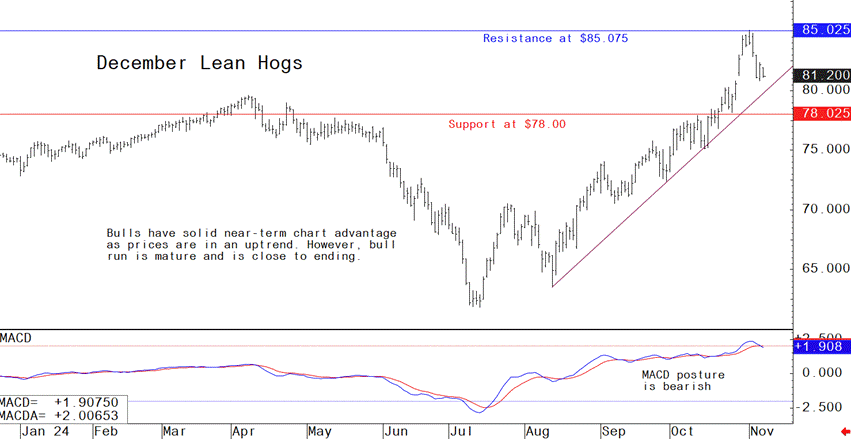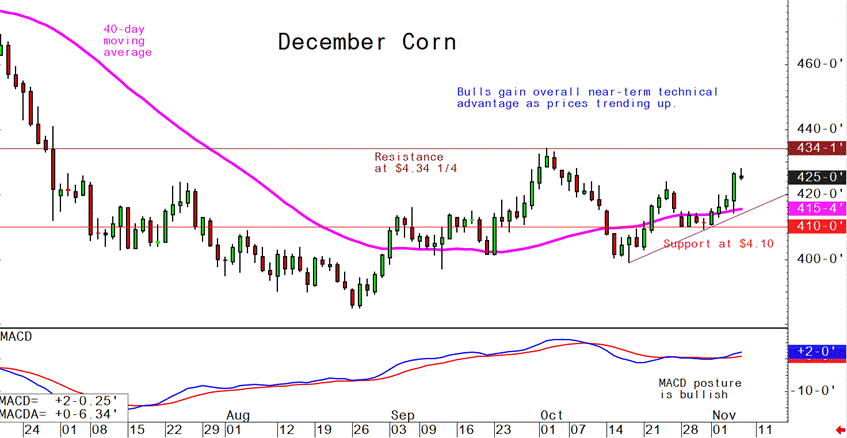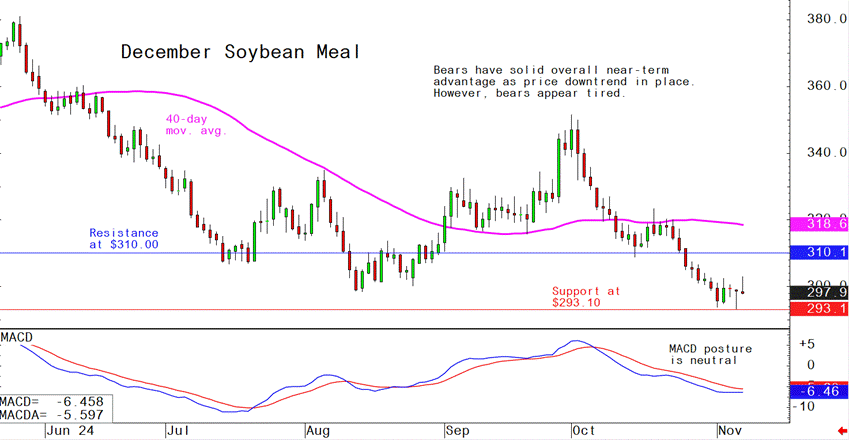



Pig outlook: Lean hog futures bulls may be getting tired
Livestock analyst Jim Wyckoff reports on global pig newsDecember lean hog futures prices last week soared to a contract high amid a steep price uptrend in still place. While the lean hog futures bulls have the solid near-term technical advantage, the recent selling pressure begins to suggest the bulls are getting tired in this very mature bull market run. It’s my bias that the hog futures market has, or is close to, topping out. The latest CME lean hog index is up another 45 cents to $90.24 as of Nov. 5, the 14th straight daily gain and $8.115 above Wednesday’s closing price in December hog futures. The strength in the cash market has proven stronger than traders expected as the market continues to try to determine how much smaller fourth-quarter US pork production is going to be than previously anticipated. Still, many traders anticipate the return of seasonal weakness in the cash hog market.
Latest USDA and other news regarding the global pork industry
Weekly USDA US pork export sales
Pork: Net US sales reductions of 14,700 MT for 2024--a marketing-year low--were down noticeably from the previous week and from the prior 4-week average. Increases primarily for Japan (2,300 MT, including decreases of 200 MT), South Korea (2,100 MT, including decreases of 2,900 MT), Panama (200 MT), the Dominican Republic (200 MT, including decreases of 200 MT), and Nicaragua (100 MT), were more than offset by reductions primarily for Mexico (7,700 MT), China (5,000 MT), Australia (2,900 MT), Colombia (1,500 MT), and Canada (1,100 MT). Net sales of 200 MT for 2025 were reported for South Korea (100 MT) and Vietnam (100 MT). Exports of 35,000 MT were up 8 percent from the previous week and 16 percent from the prior 4-week average. The destinations were primarily to Mexico (12,900 MT), Japan (4,200 MT), China (3,600 MT), South Korea (3,300 MT), and Colombia (2,700 MT).
China’s meat imports continue to slow
China imported 535,000 MT of meat during October, down 1.1% from September and 3.1% less than year-ago. Through the first 10 months of this year, China imported 5.475 MMT of meat, down 12.5% from the same period last year.
First case of H5N1 bird flu in swine confirmed at Oregon backyard farm
USDA's APHIS and Oregon state officials are investigating a backyard farm where H5N1 avian influenza was detected in poultry and, for the first time, in one of five pigs. Despite no signs of illness, the swine tested positive, and all were euthanized. Shared resources may have facilitated cross-species transmission. The farm has been quarantined, but USDA reassures there is no risk to the U.S. pork supply, and genomic sequencing shows no increased human transmissibility. The National Pork Producers Council emphasized that there are no safety concerns about U.S. pork supply, noting the pork industry has worked with USDA’s APHIS since 2009 to monitor for swine flu. “The entire pork industry remains committed to safeguarding food safety and human and animal health,” NPPC CEO Bryan Humphreys said in a statement. The pigs on the Oregon farm were not intended for the commercial food supply, USDA said.
Of note: Pigs represent a particular concern for the spread of bird flu because they can become co-infected with bird and human viruses, which could swap genes to form a new, more dangerous virus that can more easily infect humans.
The case was one factor that drove the USDA to broaden its bird flu surveillance to include nationwide bulk milk testing, which the agency announced on Wednesday, USDA Secretary Tom Vilsack told Reuters in an interview (see next item). "While it’s a different variation of the virus and it is tied to wild birds, it is a factor to make sure that we understand and appreciate exactly where the virus is in dairy" and in cattle, he said.
The detection is a warning for pig farmers to be on the lookout for further infections, said Marie Culhane, a professor of veterinary population medicine at the University of Minnesota who has researched flu viruses in swine.
"People need to start increasing their plans to deal with it if it should happen in another herd and another herd," Culhane said. "Pigs are just really good at picking up influenza viruses."
The next week’s likely high-low price trading ranges:
December lean hog futures--$79.00 to 85.075 and with a sideways-lower bias
December soybean meal futures--$293.10 to $310.00, and with a sideways-higher bias
December corn futures--$4.10 to $4.34 1/4 and a sideways-higher bias
Latest analytical daily charts lean hog, soybean meal and corn futures










